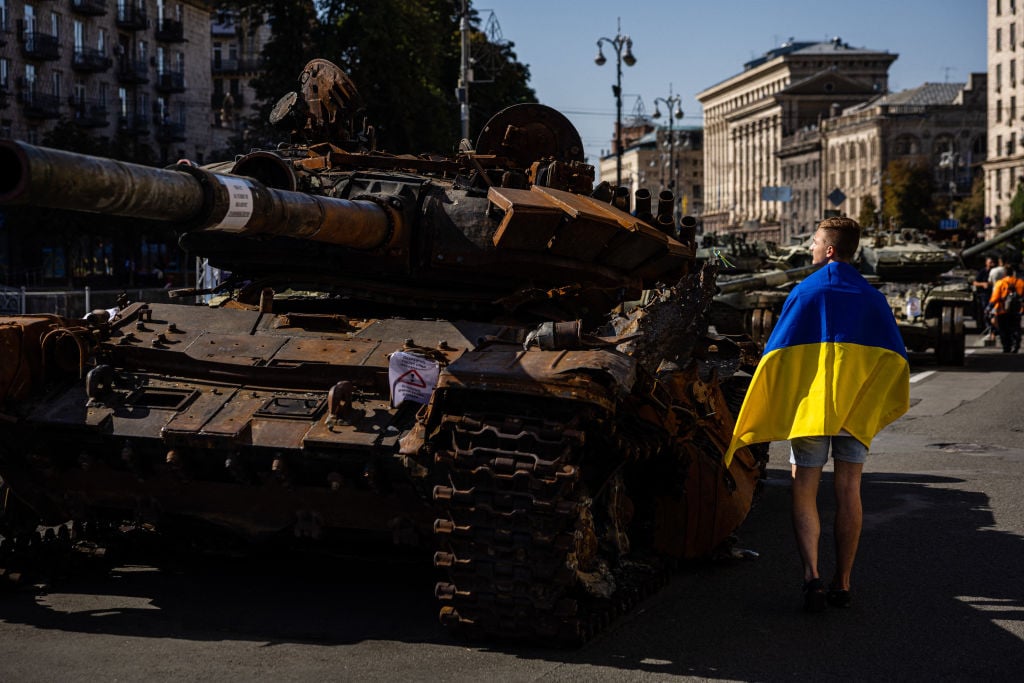
Despite Russia’s ongoing attack on Ukraine, the Kyiv Biennial will return for its 5th edition this fall with a series of dispersed exhibitions hosted at six sites internationally. The program will start in Kyiv, Ukraine, and head to Vienna, Austria, in October. Further events are planned for Warsaw, Poland, and two more Ukrainian cities, Uzhhorod and Ivano-Frankivsk, followed by several programs taking place in Berlin, Germany, in 2024.
It was not clear until recently whether going ahead with this year’s edition would be possible. “It’s one of the roles of the cultural realm to counter the logic of war, which also attacks everything that is civil by destroying cultural infrastructure,” Vasyl Cherepanyn, who co-organizes the biennial, told Artnet News. “This is a deliberate attack on our cultural identity. It’s very important to counter these genocidal intentions.”
The Kyiv Biennial was founded in 2015, partly in response to the 2014 Maidan Revolution, also known as the Revolution of Dignity, and Russia’s subsequent invasion of Crimea that same year. In the years since, the biennial has promoted art as a crucial but under-utilized means of activism, resistance, and political engagement, marking the centenary of the October Revolution in 2017, revisiting the Chernobyl disaster and the fall of the Berlin Wall in 2019, and, in 2021, spotlighting anti-fascist alliances across Europe as well as decolonization processes in Eastern Europe.
This year’s edition will address the immediate aftershocks of war and displacement, as well as Russia’s historical and ongoing cultural attack on Ukraine’s land, people, and way of life. Due to its international sprawl and extended run, the biennial has been recast as a European “perennial” project that foregrounds the importance of international solidarity and unifies the Ukraine’s artistic community which is currently scattered across Europe.
Members of the public relax by the Dnipro River after the water receded due to the blowing up of the Kakhovka Dam by Russian occupiers on June 6, 2023. Photo by Ukrinform/NurPhoto via Getty Images.
In Kyiv, the Dovzhenko Centre will use its extensive film archive to present a visual project about Ukraine’s Dnipro River, tracing its historical role in dividing the territory of Ukraine, its symbolic resonances in art and literature, and its recent weaponization through the devastating breach of the Kakhovka Dam by Russian forces in June.
Two more exhibitions will take place at the art gallery Asortymentna Kimnata in Ivano-Frankivsk and at the venue Sorry, No Rooms Available in Uzhhorod, both cities in western Ukraine that lie relatively far from the frontline. The venues emerged in their current form as a result of the war, offering emergency residencies for artists evacuated from more heavily bombarded areas. Artworks produced over the past 15 months will be exhibited with the hope of supporting these new initiatives and making them sustainable models long-term.
“The artists [exhibiting in the biennial] were not only seeking refuge, but also conditions to live and work while staying in Ukraine,” explained Cherepanyn. “This is a really unique social phenomenon, because these places are a melting pot for artists and curators from different regions and have become very productive sites for collaboration.”
Although it felt important that the biennial take place inside Ukraine “against all odds,” the situation remains unpredictable enough that the main part of the show will be hosted by tranzit.at at Vienna’s Augarten Contemporary. A long-standing partner of the biennial, this fringe cultural hub helped set up Office Ukraine Vienna, an initiative that supported Ukrainian artists and curators who had fled the war. The exhibition will host around 30 or 40 artists from Ukraine and other countries.
“It is not just Ukrainian or Eastern European artists who have a lot to say about the war. It is important that Western artists respond” said Cherepanyn. “This is not just a local conflict between some Slavic nations. One of the purposes of this exhibition is to get an understanding that this is a major European war. How did a new fascist war in Europe become possible? The whole continent has to deeply rethink how ‘never again’ became possible again.”
More Trending Stories: